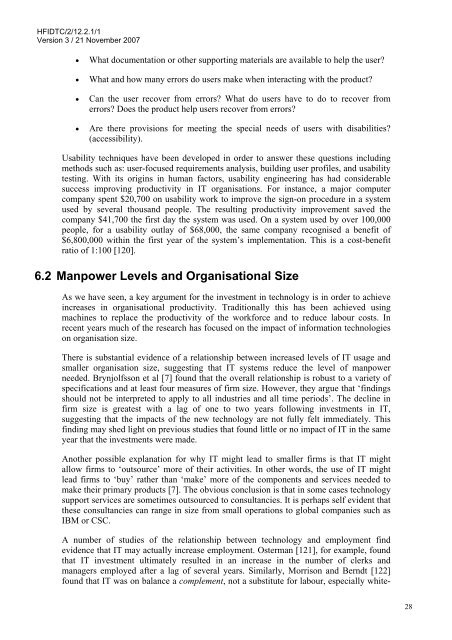The Impact of Technology Insertion on Organisations
The Impact of Technology Insertion on Organisations
The Impact of Technology Insertion on Organisations
You also want an ePaper? Increase the reach of your titles
YUMPU automatically turns print PDFs into web optimized ePapers that Google loves.
HFIDTC/2/12.2.1/1<br />
Versi<strong>on</strong> 3 / 21 November 2007<br />
• What documentati<strong>on</strong> or other supporting materials are available to help the user?<br />
• What and how many errors do users make when interacting with the product?<br />
• Can the user recover from errors? What do users have to do to recover from<br />
errors? Does the product help users recover from errors?<br />
• Are there provisi<strong>on</strong>s for meeting the special needs <str<strong>on</strong>g>of</str<strong>on</strong>g> users with disabilities?<br />
(accessibility).<br />
Usability techniques have been developed in order to answer these questi<strong>on</strong>s including<br />
methods such as: user-focused requirements analysis, building user pr<str<strong>on</strong>g>of</str<strong>on</strong>g>iles, and usability<br />
testing. With its origins in human factors, usability engineering has had c<strong>on</strong>siderable<br />
success improving productivity in IT organisati<strong>on</strong>s. For instance, a major computer<br />
company spent $20,700 <strong>on</strong> usability work to improve the sign-<strong>on</strong> procedure in a system<br />
used by several thousand people. <str<strong>on</strong>g>The</str<strong>on</strong>g> resulting productivity improvement saved the<br />
company $41,700 the first day the system was used. On a system used by over 100,000<br />
people, for a usability outlay <str<strong>on</strong>g>of</str<strong>on</strong>g> $68,000, the same company recognised a benefit <str<strong>on</strong>g>of</str<strong>on</strong>g><br />
$6,800,000 within the first year <str<strong>on</strong>g>of</str<strong>on</strong>g> the system’s implementati<strong>on</strong>. This is a cost-benefit<br />
ratio <str<strong>on</strong>g>of</str<strong>on</strong>g> 1:100 [120].<br />
6.2 Manpower Levels and Organisati<strong>on</strong>al Size<br />
As we have seen, a key argument for the investment in technology is in order to achieve<br />
increases in organisati<strong>on</strong>al productivity. Traditi<strong>on</strong>ally this has been achieved using<br />
machines to replace the productivity <str<strong>on</strong>g>of</str<strong>on</strong>g> the workforce and to reduce labour costs. In<br />
recent years much <str<strong>on</strong>g>of</str<strong>on</strong>g> the research has focused <strong>on</strong> the impact <str<strong>on</strong>g>of</str<strong>on</strong>g> informati<strong>on</strong> technologies<br />
<strong>on</strong> organisati<strong>on</strong> size.<br />
<str<strong>on</strong>g>The</str<strong>on</strong>g>re is substantial evidence <str<strong>on</strong>g>of</str<strong>on</strong>g> a relati<strong>on</strong>ship between increased levels <str<strong>on</strong>g>of</str<strong>on</strong>g> IT usage and<br />
smaller organisati<strong>on</strong> size, suggesting that IT systems reduce the level <str<strong>on</strong>g>of</str<strong>on</strong>g> manpower<br />
needed. Brynjolfss<strong>on</strong> et al [7] found that the overall relati<strong>on</strong>ship is robust to a variety <str<strong>on</strong>g>of</str<strong>on</strong>g><br />
specificati<strong>on</strong>s and at least four measures <str<strong>on</strong>g>of</str<strong>on</strong>g> firm size. However, they argue that ‘findings<br />
should not be interpreted to apply to all industries and all time periods’. <str<strong>on</strong>g>The</str<strong>on</strong>g> decline in<br />
firm size is greatest with a lag <str<strong>on</strong>g>of</str<strong>on</strong>g> <strong>on</strong>e to two years following investments in IT,<br />
suggesting that the impacts <str<strong>on</strong>g>of</str<strong>on</strong>g> the new technology are not fully felt immediately. This<br />
finding may shed light <strong>on</strong> previous studies that found little or no impact <str<strong>on</strong>g>of</str<strong>on</strong>g> IT in the same<br />
year that the investments were made.<br />
Another possible explanati<strong>on</strong> for why IT might lead to smaller firms is that IT might<br />
allow firms to ‘outsource’ more <str<strong>on</strong>g>of</str<strong>on</strong>g> their activities. In other words, the use <str<strong>on</strong>g>of</str<strong>on</strong>g> IT might<br />
lead firms to ‘buy’ rather than ‘make’ more <str<strong>on</strong>g>of</str<strong>on</strong>g> the comp<strong>on</strong>ents and services needed to<br />
make their primary products [7]. <str<strong>on</strong>g>The</str<strong>on</strong>g> obvious c<strong>on</strong>clusi<strong>on</strong> is that in some cases technology<br />
support services are sometimes outsourced to c<strong>on</strong>sultancies. It is perhaps self evident that<br />
these c<strong>on</strong>sultancies can range in size from small operati<strong>on</strong>s to global companies such as<br />
IBM or CSC.<br />
A number <str<strong>on</strong>g>of</str<strong>on</strong>g> studies <str<strong>on</strong>g>of</str<strong>on</strong>g> the relati<strong>on</strong>ship between technology and employment find<br />
evidence that IT may actually increase employment. Osterman [121], for example, found<br />
that IT investment ultimately resulted in an increase in the number <str<strong>on</strong>g>of</str<strong>on</strong>g> clerks and<br />
managers employed after a lag <str<strong>on</strong>g>of</str<strong>on</strong>g> several years. Similarly, Morris<strong>on</strong> and Berndt [122]<br />
found that IT was <strong>on</strong> balance a complement, not a substitute for labour, especially white-<br />
28

















